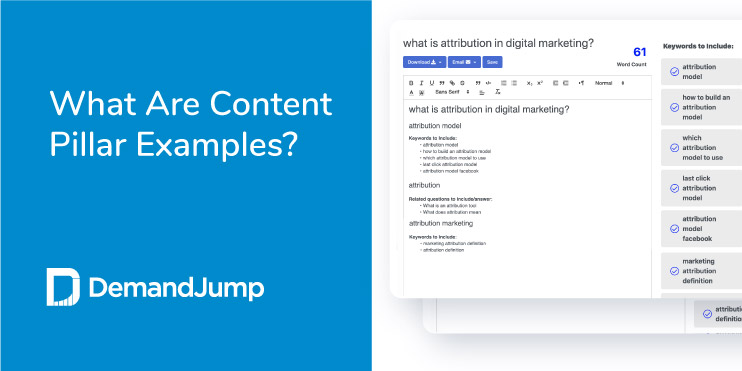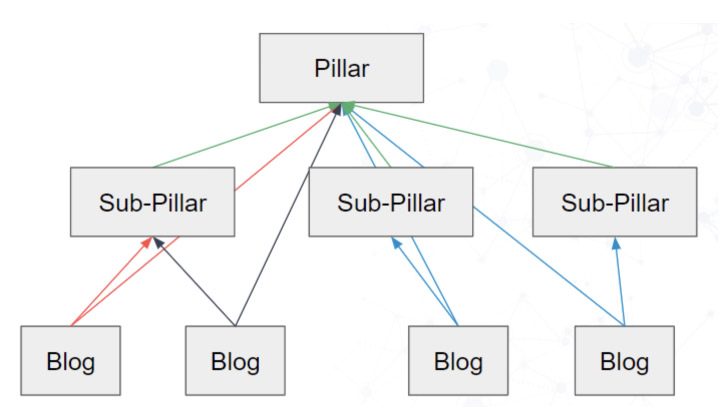What Are Content Pillar Examples?
February 18, 2022 •Clare Sheehan

It’s pretty clear that the SEO Pillar content strategy is taking the digital content world in a whole new direction. Creating SEO-powered content pillars that are valuable and relevant to your readers will routinely land you a spot on page one of Google. But how do you come up with content pillars?
In this blog, we’ll discuss what content pillars are, list some pillar page examples, and offer a working content pillar template to help you get started with your content journey and drive page one outcomes.
What Is a Content Pillar?
A content pillar strategy is designed to help you receive as much traffic as you can from Google by providing a network of content on your chosen topic. The core mechanism of the content pillar strategy is the content cluster. The content cluster is a network of content made up of pillar pages, sub-pillar pages, and blogs of varying lengths. Here is what a content cluster looks like broken out into its separate parts:
Pillar Pages: The main piece of content in the content cluster. It is also the largest, with a word count of about 3,000. There is only one pillar in each content cluster.
Sub-Pillars: The secondary pieces of content in a content cluster. Support pillars have a word count of about 2,000. There are, typically, 3 sub-pillars in each content cluster.
Blogs: The last pieces of content in the content cluster. Blogs are shorter in length and have a word count of about 750. There are, typically, 4 blogs in each content cluster.

Using a content pillar strategy creates a deep and rich web of content that is able to grab the search engine’s attention and drive your content to page one.
Generating Content Pillar Ideas
You can develop concrete and relevant content pillar ideas by taking some time to examine what your company offers, and evaluating who your target audience is. Here is a content pillar template for you to use as a reference.
- Choose Your Pillar Topic. Your pillar topic should be broad, but not unmanageable. Remember, whatever topic you choose for your pillar informs the rest of your content cluster.
- Conduct Your Keyword Research. After you have identified your pillar topic, the next step is to determine which keywords and questions are the best for your overall SEO keyword research strategy. Struggling to decide which keywords will help you rank on page one? DemandJump’s got you covered. Our platform automates hours of keyword and SEO research to help you create more valuable content.
- Choose Your Support Pillar Topics. The keywords and questions you identified in your SEO research process will help you determine the topics of your sub-pillars and blogs.
Advice From a DemandJump Writer
At DemandJump, we employ a team of master content creators. Here’s some content creation advice from a member of our DemandJump content team.
“I find it very helpful to create a sort of miniature thesis statement for each piece of content I write. This helps me base my writing around a central and cohesive idea. This is extremely helpful for choosing keywords and creating the layout of your piece of content. I make sure all of the keywords and sections of my content piece ultimately relate to the thesis statement I outlined in the beginning. This keeps me on track and prevents me from going off on unnecessary tangents.”
Clare Sheehan | Content Manager
Examples of Content Pillars
Example 1: Content Pillar For a Wedding Planner
Here is a hypothetical example of a content pillar strategy for an Indianapolis-based wedding planner who wants to drive more organic leads through their website. After narrowing down what their audience is interested in through SEO keyword research, they identified the pillar topic as Seasonal Weddings.
Their main pillar would be titled “Seasonal Weddings” and would be a 3,000-word article encompassing everything a person planning a Seasonal Wedding would need to know.
The wedding planner would then break down the topic of “Seasonal Weddings” into sub-pillar topics. Sub-pillar examples for the term “Seasonal Weddings” could look like:
- Fall Weddings
- Spring Weddings
- Winter Weddings
After the sub-pillars are written, the wedding planner would then identify the topics for supporting blogs that relate back to the sub-pillar content. Here are some examples of blogs that would be linked to the “Spring Weddings” sub-pillar:
- What are the most popular types of spring wedding venues?
- What are popular spring wedding dress styles?
- What food should you serve at a spring wedding?
After the pillar, sub-pillar, and blog topics have been identified it’s time to write the content.
Example 2: Content Pillar For a Small Bakery
Here is a hypothetical example of a content pillar strategy for a small-scale bakery.
The main pillar topic could be, “Baked Goods for the Holidays.”
Then the broken down sub-pillar examples for the pillar topic “Baked Goods for the Holidays” could look like:
- Christmas Cookies
- Chinese New Year Desserts
- Halloween Treats
Lastly, here are some examples of blogs that would be linked to the “Christmas Cookies” sub-pillar:
- What are some classic Christmas cookies?
- Unique Christmas cookie recipes
- Cooking Christmas cookies with kids
What Should Your Content Pillars Be? DemandJump Can Help Your Decide
Without the right keywords and insights, your content pillar strategy won’t work. As a leading Marketing Strategy Platform, DemandJump powers first page rankings and better digital outcomes. Our platform uncovers exactly what topics and keywords should inform your content creation to drive the results you deserve.
Start your journey to page one of Google today!
Featured Articles
Categories
- Attribution Tracking (13)
- Channel Optimization (11)
- Consumer Insights (68)
- Content Marketing (251)
- Data Science (8)
- Digital Marketing (6)
- Digital Transformation (26)
- Enterprise (10)
- Lead Generation (14)
- Market Intelligence (8)
- Marketing Analytics (39)
- Marketing Attribution (57)
- Marketing Management (153)
- Marketing Operations (86)
- Organic Search (222)
- Paid Search (52)
- Pillar-Based Marketing (63)
- Programmatic Advertising (9)
- SaaS Content (14)
- SaaS Marketing (29)
- Search Marketing (111)
- SEO Keyword Research (28)
- SEO Pillar (18)
- SEO Strategy (46)
- SMB (5)
- Website Content (12)


